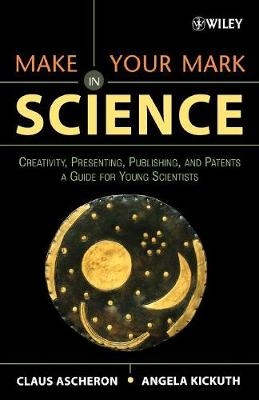
Make Your Mark in Science
Wiley-Interscience (Verlag)
978-0-471-65733-0 (ISBN)
This excellent guide tells graduate students and other young scientists and engineers everything they need to know to help them work creatively and communicate their achievements in oral presentations and written publications. Also addressing the topics of scientific ethics, electronic publishing, and patents, this concise but comprehensive book will help answer many of the questions faced by novice researchers, thereby making their tasks seem less intimidating.
CLAUS ASCHERON is Physics Editor at Springer-Verlag Heidelberg and a former professor of Kyoto University. He has given lectures on the topics of creativity, presenting, and publishing at numerous universities and professional conferences. ANGELA KICKUTH also works in science publishing and as a freelance writer and translator. Both authors have themselves survived the experience of obtaining a PhD in physics. Both also subsequently pursued careers in research, with appointments at universities and other research centers in several countries.
Preface. 1. Introduction.
1.1 What Does It Take to Be a Successful Scientist?
1.2 Creativity.
1.3 Presenting.
1.4 Publishing and Electronic Publishing.
1.5 Patents.
2. Scientific Creativity.
2.1 What is Creativity?
2.2 Creativity in Science.
2.3 Prerequisites for Creative Work.
2.4 Personal Working Conditions.
2.5 Group Creativity: Cooperation and Competition.
2.6 Intelligence and Creativity.
2.7 Scientific Creativity and Productivity Worldwide.
3. Scientific Presenting.
3.1 Planning a Presentation.
3.2 Visual Aids.
3.3 Preparing Slides.
3.4 Practicing Before the Event.
3.5 Delivering a Talk.
3.6 Surviving the Discussion.
3.7 The Art of Asking Questions.
3.8 Poster Presentations.
3.9 Some Tips for Chairing Meetings.
3.10 Dos and Don'ts.
4. The Culture and Ethics of Scientific Publishing.
4.1 Purposes of Scientific Publishing.
4.2 Types of Publications.
4.3 A Few Words About Ethics.
5. Writing and Publishing Your Own Paper.
5.1 Planning and Preparation.
5.2 Style of Writing.
5.3 Structure of a Scientific Paper.
5.4 Formal Aspects of Manuscript Preparation.
5.5 Submission, Refereeing, Revisions.
5.6 Writing for Profit?
5.7 Dos and Don'ts.
6. Electronic Publishing.
6.1 Milestones in the Development of Electronic Publishing.
6.2 Today's Electronic Media and Products.
6.3 Use and Benefits of Online Publications.
6.4 The Roles of the Publisher.
6.5 Problems and Potential Pitfalls.
6.6 Future Prospects, Near and Medium-Term.
6.7 Open Access Publications.
7. Patents.
7.1 Introduction.
7.2 What Is a Patent?
7.3 What Can and Can't Be Patented?
7.4 Conditions for Patentability.
7.5 Who Should Apply? Patent Ownership.
7.6 Before You Apply.
7.7 Patent Application Procedure: Example of European Patent Office.
7.8 The Patent Examination Process (EPO).
7.9 Differences Between US and European Patents.
7.10 Costs of Patents.
7.11 Getting Assistance.
7.12 A Little Relief.
| Erscheint lt. Verlag | 1.2.2005 |
|---|---|
| Sprache | englisch |
| Maße | 140 x 218 mm |
| Gewicht | 331 g |
| Einbandart | Paperback |
| Themenwelt | Naturwissenschaften |
| Technik ► Elektrotechnik / Energietechnik | |
| ISBN-10 | 0-471-65733-6 / 0471657336 |
| ISBN-13 | 978-0-471-65733-0 / 9780471657330 |
| Zustand | Neuware |
| Haben Sie eine Frage zum Produkt? |
aus dem Bereich


